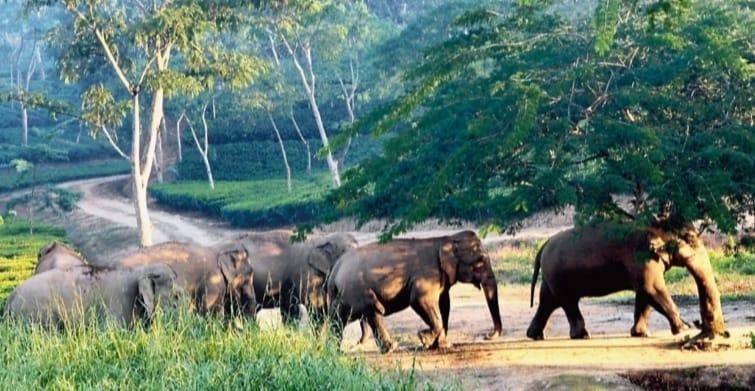Published: 06:18 PM, 21 August 2025
Transboundary Conservation Challenges and Biodiversity Status of Patharia Hills in Bangladesh–India Border

Sangram Datta
Patharia Hills, a significant evergreen forest region spanning the Bangladesh–India border, is an ecological hotspot harboring diverse flora and fauna, including endangered species such as the Asian elephant. Over the past five decades, the forest area has declined drastically due to anthropogenic pressures such as encroachment, monoculture plantations, and habitat fragmentation. This report synthesizes current knowledge on the geographical features, biodiversity, threats, and urgent conservation needs of Patharia Hills, with a focus on the critical transboundary elephant corridor. It underscores the necessity of coordinated India–Bangladesh conservation initiatives to restore habitat connectivity and prevent local extinction of key species.
Patharia Hills, located across Barlekha and Juri upazilas in Moulvibazar district, Bangladesh, and adjacent Karimganj district in India, represents one of the last remaining evergreen forest ecosystems in the region. Characterized by diverse topography, rich biodiversity, and vital ecological functions, Patharia has experienced severe habitat loss and degradation over recent decades. This report examines the current status of the ecosystem, highlights key threats, and discusses proposed conservation strategies with a particular emphasis on the Asiatic elephant population.
Geographic and Ecological Characteristics:
The hill range extends approximately 40 kilometers north to south and was formed during the mid-Pleistocene epoch. The topography includes three prominent peaks—Durbin Tila, Gagan Tila, and Rajbari Tila—each approximately 244 meters in elevation. The forest encompasses the Gangamara (upper hills) and Madhabchhara (lower hills) zones, including the notable Madhabkunda Waterfall, a significant cultural and tourist landmark.
The forest area has contracted from approximately 1,152 km² in 1967 to 135 km² as of the latest assessments, with 65% lying within Bangladesh and 35% in India.
Biodiversity Overview:
The evergreen forest supports a complex assemblage of flora, including:
Dominant canopy species: fig (Ficus spp.), various deciduous trees
Understory vegetation: bamboo groves, creepers, shrubs
Flowering plants: Ashoka (Saraca asoca), Orchid Tree (Bauhinia variegata), Golden Champa (Michelia champaca), Parul (Tabebuia rosea), magnolia species
Fruit-bearing trees: jamun (Syzygium cumini), mango (Mangifera indica), wild mango (Mangifera sylvatica), jackfruit (Artocarpus heterophyllus), bahera (Terminalia bellirica), haritaki (Terminalia chebula), lemon (Citrus limon)
Fauna includes endangered and rare species such as the Asian elephant (Elephas maximus), ferret badger (Melogale moschata), red panda-like bamboo bear (Ailurus fulgens – locally reported), porcupines, fishing cats (Prionailurus viverrinus), deer, pythons, and multiple avian species.
Recent camera trap surveys confirm the continued presence of several threatened species, although large carnivores like leopards (Panthera pardus) or clouded leopards (Neofelis nebulosa) are likely extirpated or extremely rare.
Anthropogenic Threats:
Key drivers of ecological decline include:
Encroachment and Land Grabbing: Construction of residential and luxury buildings by influential actors on government forest lands and border zones.
Monoculture Plantations: Replacement of native fruit- and food-bearing trees with acacia monocultures, reducing food availability for wildlife.
Resource Exploitation: Unregulated bamboo harvesting, timber extraction, brick kiln operations, pond digging, and unplanned road construction causing habitat fragmentation.
Forest Fires: Notable incidents such as the March 2023 blaze affecting approximately 40 hectares.
Illegal Hunting and Poaching: Cross-border hunting activities exacerbated by inadequate enforcement.
Human–Wildlife Conflict: Crop raiding by elephants, electrocution of wildlife, and accidental deaths.
The Transboundary Elephant Corridor and Conservation Imperatives:
The Patharia–Karimganj region functions as an essential corridor for the Asian elephant, facilitating movement between Bangladesh and India. The local population comprises only female elephants on both sides (four in Bangladesh, six in India), with an absence of males preventing reproduction and threatening population viability.
A study published in the Journal of Threatened Taxa (Choudhury et al.) advocates urgent cross-border cooperation for:
Habitat protection and corridor restoration
Translocation of a male elephant following IUCN guidelines to enable breeding
Mitigation of human–elephant conflicts through community engagement and infrastructure modification
Local communities express support for conservation efforts, conditional upon protection from crop damage.
Recommendations and Conclusion:
Effective conservation of Patharia Hills requires immediate, coordinated action:
Legal protection by declaring Patharia a wildlife sanctuary or protected area
Transparent land audits and reclamation of encroached lands
Restoration of native tree species to revive ecological functions
Formation of joint India–Bangladesh conservation bodies to manage transboundary corridors
Strengthening anti-poaching measures and integrating community participation
Implementing compensation and alternative livelihood schemes for affected communities
Infrastructure adjustments to reduce wildlife mortality
Development of sustainable rehabilitation and translocation protocols for endangered species
Failure to act threatens the loss of a unique transboundary ecosystem, critical biodiversity, and cultural heritage. This report calls for urgent attention from governmental agencies, researchers, NGOs, and local stakeholders to secure the future of Patharia Hills.




